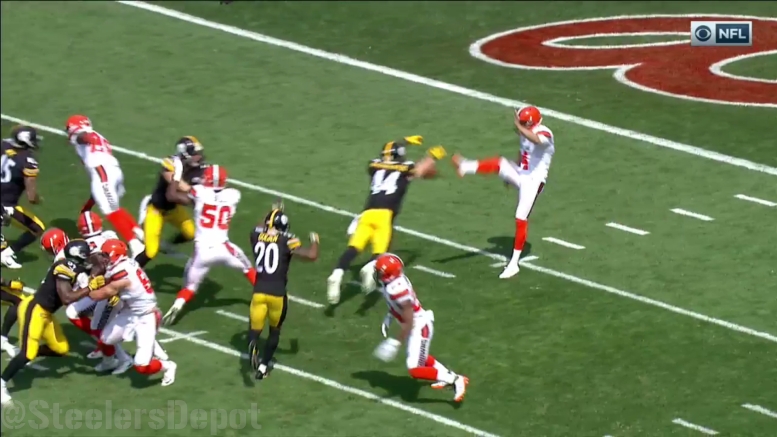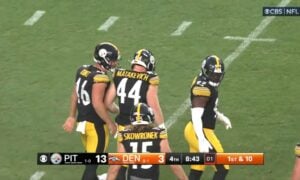It seems to me that a good number of people do not find special teams play to be as interesting or as important as we do, ‘we’ being the Steelers Depot staff. It is, to be blunt, the only portion of the average football game is not actually subjected to analysis, so it is understandable to a degree why it might be largely discarded.
Not that that is the only reason. With the number of kickoffs that end in touchbacks today—of the eight kickoffs by either team Sunday, only two were returned, and one was a deliberate squib kick—and the fact that most extra point and field goal attempts are viewed as automatic, it is largely taken for granted that special teams is not all that important.
One of the problems in talking about special teams is the fact that there is very little statistical input to talk about when it comes to anybody who is not a kicker or a punter, and even for the punter, his numbers require a lot of context, because a 30-yard punt can be amazing or awful depending on where the line of scrimmage is.
So starting with this season I want to try to put some numbers and analysis into special teams play in order to try to fill a sort of void when it comes to analysis. I want people to understand that Darrius Heyward-Bey, for example, is a far bigger contributor than his six tackles last year would suggest. That begins now.
The Pittsburgh Steelers’ season opener made it obvious pretty early just how important special teams can be when they recovered a blocked punt for a touchdown two minutes into the game. These are things that everybody notices, but are regarded as so rare that they are not important. The team had not recovered a punt for a touchdown in nearly two decades prior.
As Alex Kozora already appropriately analyzed earlier in the week, the Steelers were able to take advantage of a miscommunication on the punt when the long snapper passed off the initial rusher, Tyler Matakevich, to pick up L.J. Fort, assuming that the upback would know to pick up Matakevich.
The Browns’ upback? Rookie running back Matthew Dayes, who did not pick up the first rusher. Read Alex’s article as he explains the importance of the upback role, but I think this play makes it obvious. This is why Robert Golden is so valued.
You won’t be surprised to read this, but Roosevelt Nix popped a Browns coverage player on a touchback. It’s just what he does.
Jordan Berry’s first punt from his own 42-yard line made it to the Browns’ 13, but because Mike Hilton got wedged by Cleveland’s vice jammers, Jabrill Peppers had the right side of the field to work with despite pressure from the left side by Heyward-Bey, so he was able to return it nine yards to the 22, getting out of bounds without even being touched. According to my stopwatch, Berry’s hangtime was subpar, around 3.7 seconds.
Nix was about a foot away from blocking another punt, evading to the inside a cut-block attempt from the right wing. Considering the 46-yard punt was downed at the six-yard line, that would have made a big difference.
Berry’s third punt traveled only 30 yards before taking a friendly bounce another nine yards and out of bounds. It was his second punt out of bounds, though the first went 48 yards. Even that only reached the 32-yard line, however.
Another Browns punt traveled just 26 yards but was downed at the 14. It’s important to remember context: a 26-yard net punt can be good.
Berry’s longest gross punt of the day travel d 59 yards, but was straight down the center of the field with a four-second hang time. That was not long enough for his gunners to cover the distance and allowed Peppers to return it 25 yards, resulting in just a 34-yard net punt.
Heyward-Bey did draw an appropriate holding call on a later punt return.
One thing that enabled L.J. Fort to record a tackle at the 14-yard line on a kickoff was Terrell Watson absorbing the block of the upback. Fort’s second special-teams tackle came on a muffed punt that was just tagging Peppers down after falling on the ball to regain possession.
Artie Burns needs to work on his jamming, something he’s doing for I think the first time in his career during this regular season, but he gives max effort on the field goal blocking unit. I could see him getting a piece of one off the edge some day.
On the one punt of the day on which Berry got good hangtime—about 4.5 seconds—Heyward-Bey was down there to induce the fair catch. His tally for the season so far is one induced fair catch and one special-teams tackle.
Also worth noting that very late in the game they put J.J. Wilcox in as a gunner. He replaced Hilton.
On the Browns’ late squib kick from the 50-yard line, JuJu Smith-Schuster was the only one back to receive the kick. Remember, if the kicking team recovers the ball on a kickoff, it’s theirs.
Two of the three Browns kickoffs leading up to the squib kick were angled at Watson, the other angled at Smith-Schuster.
If there are other things regarding special-teams play on a weekly basis that you would like to see, feel free to mention it.








